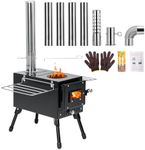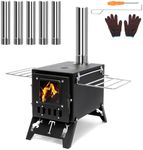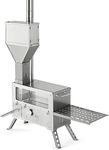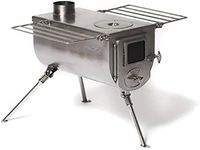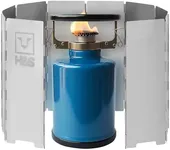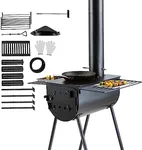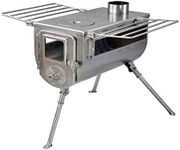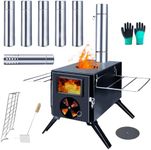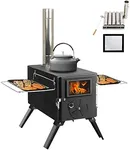Buying Guide for the Best Wood Stove For Tent
Choosing a wood stove for your tent is all about balancing warmth, safety, portability, and ease of use. The right stove can make your camping experience much more comfortable, especially in colder weather. Before you buy, think about the size of your tent, how often you’ll use the stove, and how much weight you’re willing to carry. Also, consider how easy it is to set up and maintain the stove, as well as how safe it is to use in an enclosed space. Understanding the key features will help you pick a stove that fits your needs and keeps you cozy during your outdoor adventures.Size and Heating CapacityThe size and heating capacity of a wood stove determine how much space it can effectively warm. This is usually measured by the size of the firebox and the amount of heat it can produce. Smaller stoves are lighter and easier to carry but may not provide enough heat for larger tents, while bigger stoves can heat larger spaces but are heavier and bulkier. To choose the right size, consider the dimensions of your tent and the typical weather conditions you’ll face. If you have a small tent or only camp in mild weather, a compact stove is usually enough. For larger tents or colder climates, opt for a stove with a bigger firebox and higher heat output.
PortabilityPortability refers to how easy it is to transport and set up the stove. Some wood stoves are designed to be lightweight and foldable, making them ideal for backpacking or situations where you need to carry your gear over long distances. Others are more robust and heavier, better suited for car camping or base camps. If you plan to move your stove frequently or carry it far, look for models that break down into smaller parts or have carrying handles. If you’ll mostly be driving to your campsite, portability may be less of a concern.
Material and DurabilityThe material of the stove affects its weight, durability, and how well it retains heat. Common materials include steel, stainless steel, and titanium. Steel stoves are sturdy and hold heat well but can be heavy. Stainless steel offers a good balance between weight and durability, while titanium is very light but often more expensive. If you need a stove for frequent use or harsh conditions, prioritize durability. For occasional use or when weight is a major concern, lighter materials may be preferable.
Chimney and VentilationA chimney or flue is essential for venting smoke and gases safely out of your tent. The length and design of the chimney affect how well the stove draws air and removes smoke. Some stoves come with adjustable or modular chimneys, which can be tailored to different tent heights. Make sure the stove you choose has a reliable chimney system and that it’s compatible with your tent’s stove jack (the opening for the chimney). Good ventilation is crucial for safety, so always ensure the chimney is properly installed and maintained.
Safety FeaturesSafety features help prevent accidents like burns or carbon monoxide buildup. Look for stoves with stable bases, spark arrestors (which prevent embers from escaping the chimney), and heat shields to protect your tent fabric. Some stoves also have glass windows so you can monitor the fire without opening the door. If you’re new to using wood stoves in tents, prioritize models with clear safety instructions and built-in safety features to reduce risks.
Ease of Use and MaintenanceHow easy a stove is to set up, operate, and clean can make a big difference in your camping experience. Some stoves have simple designs with few parts, making them quick to assemble and disassemble. Others may require more effort to set up or clean. If you want a hassle-free experience, look for stoves with straightforward assembly, easy access for cleaning out ash, and user-friendly controls for adjusting airflow and heat.

